6 Years Later, Star Trek is Undoing a Controversial Canon Change
The Discovery- era Klingons are “in the rearview mirror.”

Hardcore Star Trek fans know that for every single change to a classic alien species, there’s usually some kind of in-universe explanation. But when it comes to the debut of new Klingons in the first episode of Strange New Worlds Season 2, maybe there’s not. If you’re wondering if there will ever be a reappearance of the radical Nosferatu-esque Klingons from Star Trek: Discovery Season 1 and Season 2, the short answer is: not likely.
Ahead of the launch of Star Trek: Strange New Worlds Season 2 , showrunners Akiva Goldsman and Henry Alonso Myers spoke about Discovery canon, what to expect in the new season, and why Klingons look the way they do. Spoilers ahead.
In “The Broken Circle,” the Enterprise crew deals with the fallout from the Klingon War. Some Klingons and humans profited from the war, and are trying to make it start all over again. To that end, a rogue group of arms dealers, “The Broken Circle” have even constructed a faux Starfleet ship, to make it look like the Federation is trying to reignite the conflict. Attentive fans will notice that Mitchell (Rong Fu) tells Spock (Ethan Peck) that this ship is a “Crossfield-class” starship, and that its saucer is basically identical to the USS Discovery . Between the Klingon War references and the reappearance of the Klingons, are Discovery’s first two seasons essential viewing before Strange New Worlds Season 2?

The crew attempt to unravel the conspiracy of “The Broken Circle.”
“It’s really important that it’s not a Discovery sequel for people who don’t watch Discovery,” Akiva Goldsman tells Inverse. “What we try to do when it comes to the deeper dive into more canonical material is this: if you don’t know about that stuff, it’s a cool TV show that lives on its own. If you do know it, then it’s an utter delight. But we never use [events in other shows] foundationally for story structure or emotion unless we re-explain it and recharge it so that it’s new in the episode.”
So, no, Star Trek is not the MCU, even though there’s a faux- USS Discovery in this episode, and the events of Discovery are referenced. Strange New Worlds isn’t worried about its roots, especially when it comes to Klingons. After a controversial redesign for Discovery Season 1, the Klingons that appear in Strange New Worlds Season 2 look more or less like the Klingons in most of canon, complete with those famous foreheads.
“I think we were probably a little more influenced specifically by the look of the movies,” Henry Alonso Myers tells Inverse. “But the history that nobody talks about is that in almost every show, there has been a change in the way the Klingons look. And what Discovery did was really interesting and it was specific and it was challenging. This was our chance to say that we were not changing or ruining anything that anyone else has done, but to do something that felt like its own, but very much coming from the world of the other Klingons.”

The Klingon Time Keeper (Kenneth Mitchell) and Captain Pike (Anson Mount) in Star Trek: Discovery Season 2.
Goldsman chimes in on this point and makes it clear we won’t be seeing the monster Discovery Klingons anytime soon. “Henry is very polite. I worked on Discovery and I’ll just say, it’s nice to have those Klingons in the rearview mirror.”
Regardless of which of the myriad Klingon designs you prefer, both showrunners emphasize that the overriding reason for returning to a classic design wasn’t motivated only by fan service, but also by behind-the-scenes efficiency. “A lot of what we were doing was for production purposes,” Myers says. “The [ Discovery Klingons] are tremendously hard to do. There are physical challenges, where they had to put stuff inside their mouths and cover their whole heads. It limited the number of people we could have in those roles. So, we were trying to find something in the middle that gave us the Klingon look we wanted and didn’t have any of the challenges.”
Will the Klingons return after the first episode of Strange New Worlds Season 2? Myers and Goldsman aren’t telling. But they do tease that by the end of the season, fans will see all sorts of things no one is expecting.
“There are some episodes this season that are very much in the tradition of what we generally do on Trek,” Myers says. “But I’ll just say, there are one or two, that they probably haven’t ever done on Trek before, and this is the first time.”
Star Trek: Strange New Worlds Season 2 airs new episodes on Thursdays on Paramount+.

- Science Fiction



‘Star Trek: Discovery’ Bosses Explain Redesigned Klingons (Sort Of)
- Share on Facebook
- Share on Twitter
The Star Trek franchise has undergone a fascinating design overhaul, as fifty years of technology and storytelling change the way we portray The Federation’s Kirk-era adventures. The Klingons too have been updated repeatedly, to which Star Trek: Discovery bosses explain the latest change.
Where Star Trek films famously redesigned Klingons with ridged foreheads that required in-universe explanation of the original series’ smoother look, Discovery isn’t going to strain over its Klingons’ more alien appearance. Even J.J. Abrams ’ Star Trek Into Darkness had Klingons looking a bit different than we’re used to , and showrunner Aaron Harberts tells Entertainment Weekly the latest change is par for the course:
In the different versions of Trek, the Klingons have never been completely consistent. We will introduce several different houses with different styles. Hopefully, fans will become more invested in the characters than worried about the redesign.
Here’s a new photo of the update, while we’re at it:
Featuring Sonequa Martin-Green as First Officer Michael Burnham , Star Trek: Discovery also has among the cast Rainn Wilson as Harry Mudd , Jason Isaacs as Captain Lorca , James Frain as Spock’s father Sarek, Doug Jones as an alien science officer, Adam Rapp as the TV franchise’s first openly-gay character and assorted crew and several Klingon roles . Ex-showrunner Bryan Fuller also previously stepped up to clarify his limited involvement in the project going forward .
Shooting primarily in Toronto , the new 15-episode Star Trek: Discovery takes place 10 years before Kirk’s original Enterprise mission , exploring the fallout of an event referenced, but never seen in the original series. Wrath of Khan director Nicholas Meyer has also joined the creative side along with Gene Roddenberry’s son Rod , fan-favorite Voyager novel alum Kirsten Beyer, franchise vet Joe Menosky and Heroes writer Aron Coleite.
Discovery will stream the first two episodes on CBS All-Access Sunday, September 24 (the first will air on CBS), pushing the second half of Season 1 to January 2018. We’ll likely see more from the new Star Trek at Comic-Con , so stay tuned.
More From ScreenCrush

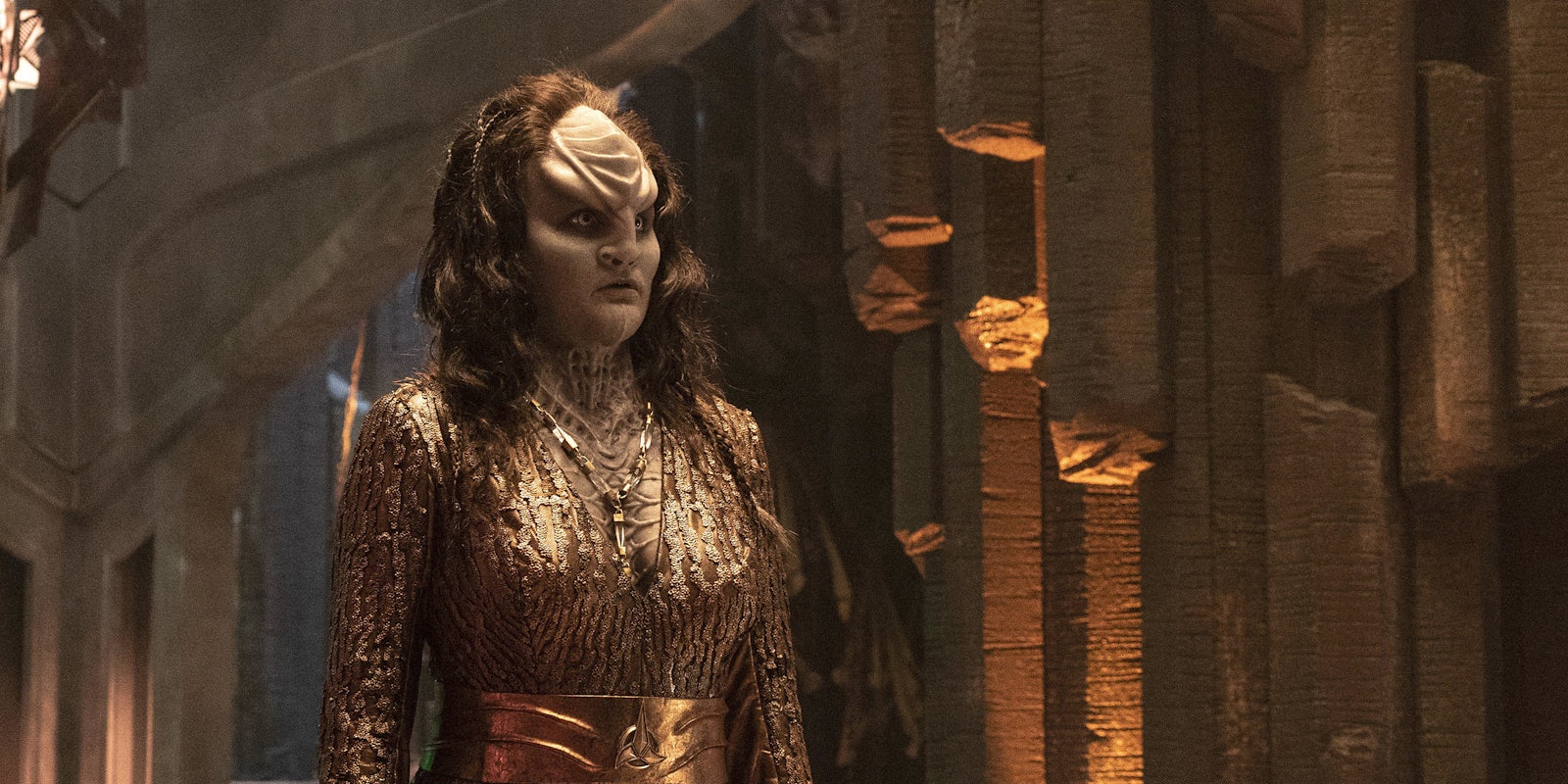
Star Trek: Discovery/CBS All Access
Here’s why the Klingons look different in ‘Star Trek: Discovery’ season 2
The klingons have hair again—and there's a canon explanation for that..

Gavia Baker-Whitelaw
Internet Culture
Posted on Jan 29, 2019 Updated on May 20, 2021, 8:25 pm CDT
When Star Trek: Discovery gave the Klingons a makeover last year, old-school Star Trek fans saw the move as pretty controversial. The Klingons had already changed a lot since their first appearance in 1967, and people were pissed about Discovery giving them yet another new look.
So for season 2, the show has decided to dial things back. Starting with this week’s episode, the Klingons will look more like they did in The Next Generation .
Each Klingon redesign has a simple real-world explanation: better makeup and prosthetics. The 1960s Klingons were essentially humans, but the original feature films and 1990s Star Trek had the budget and expertise to develop a more alien look with ridged foreheads and bushy wigs. (Those costumes also involved white actors wearing brown facepaint, a compelling reason to shake things up for Discovery .)
- Star Trek: Discovery explores the line between science and religion in ‘New Eden’
- What you need to know about Klingon culture
- How to watch ‘Star Trek: Discovery’ season 2 for free
- The best sci-fi TV shows of 2018
Star Trek Into Darkness (2013) revamped the Klingons again, making them bald and reptilian. But a lot of Trek fans hate the reboot movies, which caused a problem for Discovery . If Discovery also featured bald Klingons, it had a stronger visual link to the flashy blockbuster movies than the beloved TV franchise. This led to a weirdly intense animosity against Discovery’ s Klingons, and the showrunners decided that alien makeup was not a hill worth dying on. Along with a newly upbeat tone , season 2 will reintroduce the Klingons looking like this:
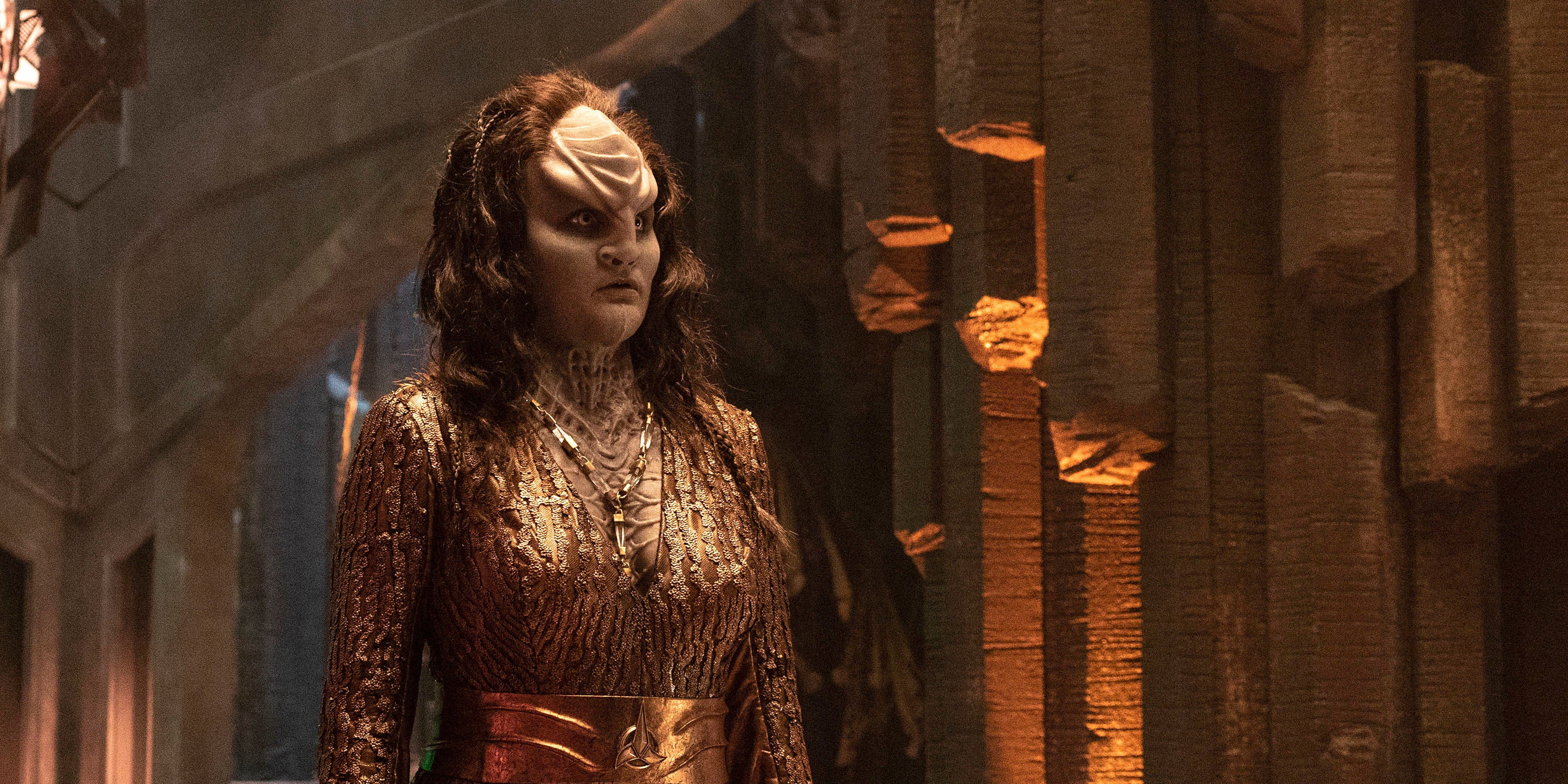
In the trailer for Thursday’s episode, “Point of Light,” you can see more Klingons with long hair, creating a closer resemblance to their 1990s look.
Why do the Klingons look different in Star Trek: Discovery season 2?
In the grand tradition of sci-fi retcons, there’s a canon explanation for the Klingons’ new look. While the humanoid Original Series Klingons were retroactively explained as victims of a genetic disease , Discovery’ s bald Klingons were apparently making a fashion statement.
According to actress Mary Chieffo (L’Rell), designer Glenn Hetrick decided that the Klingons weren’t “bald” in season one—they just shaved their heads. Speaking at New York Comic Con last year, Chieffo said Hetrick was inspired by the Next Generation episode “Rightful Heir.”
“There is a reference to when [legendary Klingon hero] Kahless is brought back as a clone. The way he proves himself is he tells the story of how he cut off a lock of his hair and dipped it into a volcano and made the first bat’leth, with which he killed Molor, the terrible tyrant who was running Qo’noS at the time. We took that one little beautiful seed… and kind of expanded on that, and we see that in a time of war the Klingons would shave their heads, and in a time of peace, we start to grow it back out. I really love the symbolism of that.”
Not only is this an impressively deep cut into Star Trek lore, it’s an appropriate addition to Klingon warrior culture. With L’Rell as the new chancellor and the Klingon Empire in turmoil after the war, we’re going to see a lot more of these guys. Season 2 will introduce more of the Klingon “houses”—each with a different aesthetic and subculture—and other planets outside the Klingon homeworld, Qo’noS.
Editor’s note: This article has been updated to clarify the Klingons in the original Star Trek movies.
Gavia Baker-Whitelaw is a staff writer at the Daily Dot, covering geek culture and fandom. Specializing in sci-fi movies and superheroes, she also appears as a film and TV critic on BBC radio. Elsewhere, she co-hosts the pop culture podcast Overinvested. Follow her on Twitter: @Hello_Tailor

Yournerdside.com
- Oct 3, 2023
Star Trek's Different Klingon Designs, Explained
Latest Your Nerd Side Show:
The Star Trek saga spans six decades and over 800 hours of storytelling on television and in film. While the universe created by Gene Roddenberry is vast and dynamic, the Klingons have appeared in every iteration of the franchise. Yet, since their debut in Star Trek: The Original Series in 1966, the Klingons' character design has changed over time. From regular humans with brown makeup and stylized facial hair to the intricate alien prosthetics on the characters in Star Trek: Discovery , there's more than one way to skin a Klingon.
Save for the odd standout like Khan Noonien Singh , heroes and starships are more important in Star Trek than its many villains . Instead, the alien antagonists that menace Starfleet explorers are mostly known by their species, like Romulans or the Borg. This is true of Klingons, which are immediately recognizable, though casual fans may not know General Chang from T'Kuvma. It wasn't until the debut of Star Trek: The Next Generation and Klingon bridge officer Worf that the franchise truly started to examine the culture of this war-like race. Thanks to his appearances in both Deep Space Nine and Star Trek: Picard Season 3 , Worf has appeared in more Star Trek episodes than any other character. He also laid the foundation for storytellers to create an in-narrative reason for the disparity in Klingon appearance. In the real world, the simple answer for the many different Klingon character designs comes down to money and technology.
The Klingons in Star Trek: The Original Series Were Simple on Purpose
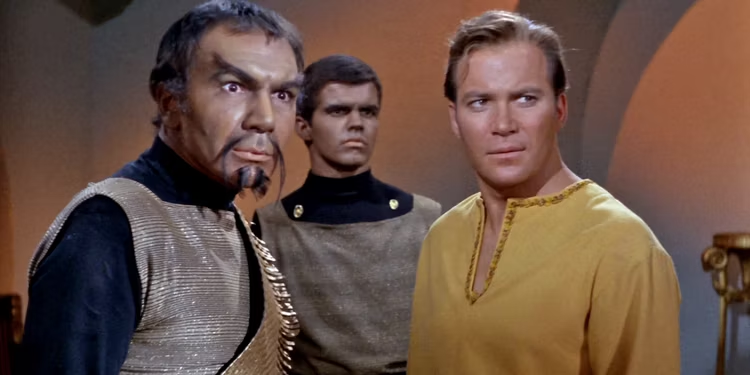
The Klingons were, effectively, created by Gene L. Coon, often called " Star Trek 's other Gene." He conceived of the characters as an allegory for the Soviet Union, according to the special features on the DVDs for Star Trek: TOS . Intended to be just one-off antagonists for the Season 1 episode, "Errand of Mercy," writer David Gerrold brought them back for Season 2's classic "The Trouble with Tribbles" episode. Crafting that story made the producers realize the Klingons could be the ongoing antagonist for Captain Kirk and the USS Enterprise crew they'd been looking for.
Despite being an expensive series, Star Trek: TOS was always struggling with budget and time. Makeup supervisor Fred Phillips worked with actor John Colicos to design the characters' look. However, outside of raised eyebrows -- similar to both Vulcans and Romulans -- and stylized facial hair, the Klingons were mostly defined by their glittery uniforms with a gold sash. The makeup process for The Original Series -era Klingons often took less time than even affixing Spock's Vulcan ears each day. The character design for early Klingons was simple and effective for TV, but that soon changed.
The Klingons Look From Star Trek: The Motion Picture Through The Next Generation Era
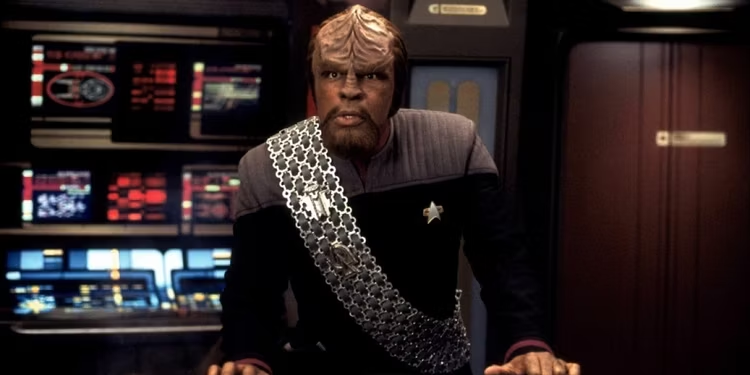
Nearly a decade after The Original Series went off-the-air, Star Trek: The Motion Picture debuted and introduced fans to a new kind of Klingons. With significantly more budget and time to work with -- the Klingons appeared in only a single scene -- Fred Phillips wanted to make the aliens truly alien. The production of the first Star Trek film was fraught, so if Gene Roddenberry had any objections to changing the Klingon character design, he had bigger battles to fight. The Klingons appeared in each successive film save for The Wrath of Khan , and while their appearance was altered slightly, they maintained the same look.
However, it wasn't until Worf was added to The Next Generation cast that Roddenberry and the writers really began to think of them as a people rather than allegorical Soviets. Now that a Klingon was a hero character, he felt it was an injustice to the characters to reduce them to just being a warrior race. "I take the fact of their fictional existence very seriously," he said in the Star Trek 25th anniversary issue of Cinefantastique . In an interview in the special features of Star Trek: TNG 's first season, actor Michael Dorn noted that Black actors were routinely cast as Klingons to simply save time in the makeup chair. Over the next 18 years, makeup supervisor Michael Westmore had to create dozens of distinct Klingon characters.
In Enterprise Season 4 , the writers addressed the incongruity of the Klingon appearance in Star Trek: TOS with the second-wave era. A storyline was introduced about a genetic modification experiment that went awry. In order to cure a deadly, multi-species virus, Klingons were given a treatment that "smoothed over" the cranial ridges and teeth added to the design to make them look more alien. Yet, even the Klingons not affected by this mutation still looked more human than not. When former Star Trek: Voyager producer Bryan Fuller wanted to redesign them for Star Trek: Discovery , making them more alien was the goal.
The Design for Klingons in Star Trek: Discovery Was Very Controversial
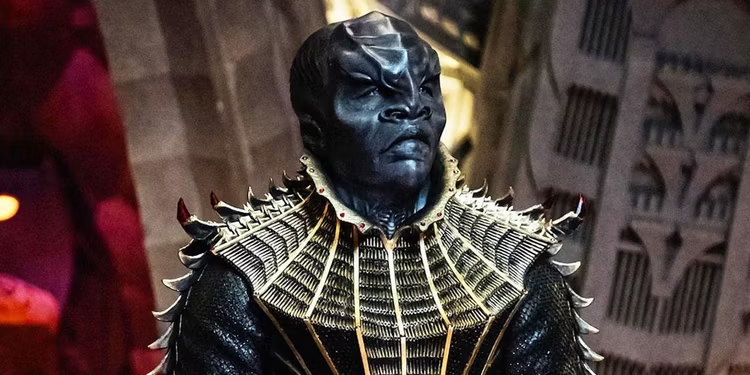
During episodes of the now-defunct After Trek webseries during Star Trek: Discovery 's first season, the Klingon redesign was an often-discussed topic. The cranial ridges and teeth Fred Phillips added during the first redesign were extended to seemingly cover their entire body. They were given longer, clawed fingers and evolutionary characteristics that were more avian or reptilian than humanoid. The hope was to make the Klingons even more alien and frightening, but the design change proved to be a bit too drastic. By Season 2, the makeup artists gave them hair again. They also introduced a number of different skin tones beyond just brown.
Yet, by Strange New Worlds Season 2, the Klingons looked more like they did during the second-wave era. Unlike Enterprise , there was no in-narrative reason or the different look. The Klingon Empire is an interstellar society with hundreds of billions of citizens. Fans can easily explain away the difference as Star Trek 's continued commitment to Roddenberry's motto of infinite diversity in infinite combinations. Klingons are also able to reproduce with other Star Trek species, which could equally explain the difference.
In both cases, the redesign of the Klingons was meant to highlight their alien nature and take advantage of state-of-the-art makeup and prosthetics. The Discovery design may have been too successful, and franchise producers seem to have reverted the iconic antagonists to their Star Trek: TNG -era design . Still, no matter what they look like, Klingons are integral to Star Trek . They are enemies who became allies, which is the lesson Roddenberry always wanted his show to teach humanity.
Recent Posts
Patrick Stewart Teases Involvement in New Star Trek Movie
Armin Shimerman Used DS9's Quark to Fix His TNG Ferengi Mistake
Lower Decks Sends Up the Beloved Picard Finale
We earn a commission for products purchased through some links in this article.

Star Trek: Discovery season 2's Klingon redesign explained by show's costume designer
Gersha Phillips shares the thought process behind the species' new look.
For the second season of the CBS All Access show, the humanoid alien species have grown their hair out, now that there is peace.
Speaking to Digital Spy , Phillips also provided insight into the differences in the armour that the Klingons wear and how they complement the storytelling.

"Those changes came from the script that we got, so it's a producer/writer-driven decision," she explained. "The idea is that because the Klingons are not at war and not at wartime, they grew their hair and they don't wear their armour in the same way.
"I did keep some armour – and also, Kol-sha was in armour – so we echoed stuff that we had done before.
"We made it a little different, but we did still echo some of the armour. Because the Klingons are a warring, militaristic species, we did want to keep some of that feeling... so when you see L'Rell at the beginning, she does have her weapon on her. She's holstered, because they're ready.
"They're still battle-ready of a certain kind, but it's slightly different."

Star Trek: Discovery boss Alex Kurtzman previously indicated that some of the fan criticism of how different the Klingons looked in the first season compared to their appearance in previous Star Trek series played a part in the redesign.
And Phillips shared that, in regards to the species' costume design, her focus was on "blending the two stories".
She said: "I think the idea was that [the producers] wanted things to be a little more cohesive with the canon while keeping what we started with – blending the two stories. It's a combination of both, in my mind.
"I'm really proud of what we did. I think they look great – and there's definitely some good stuff coming up, so that will be great, too."
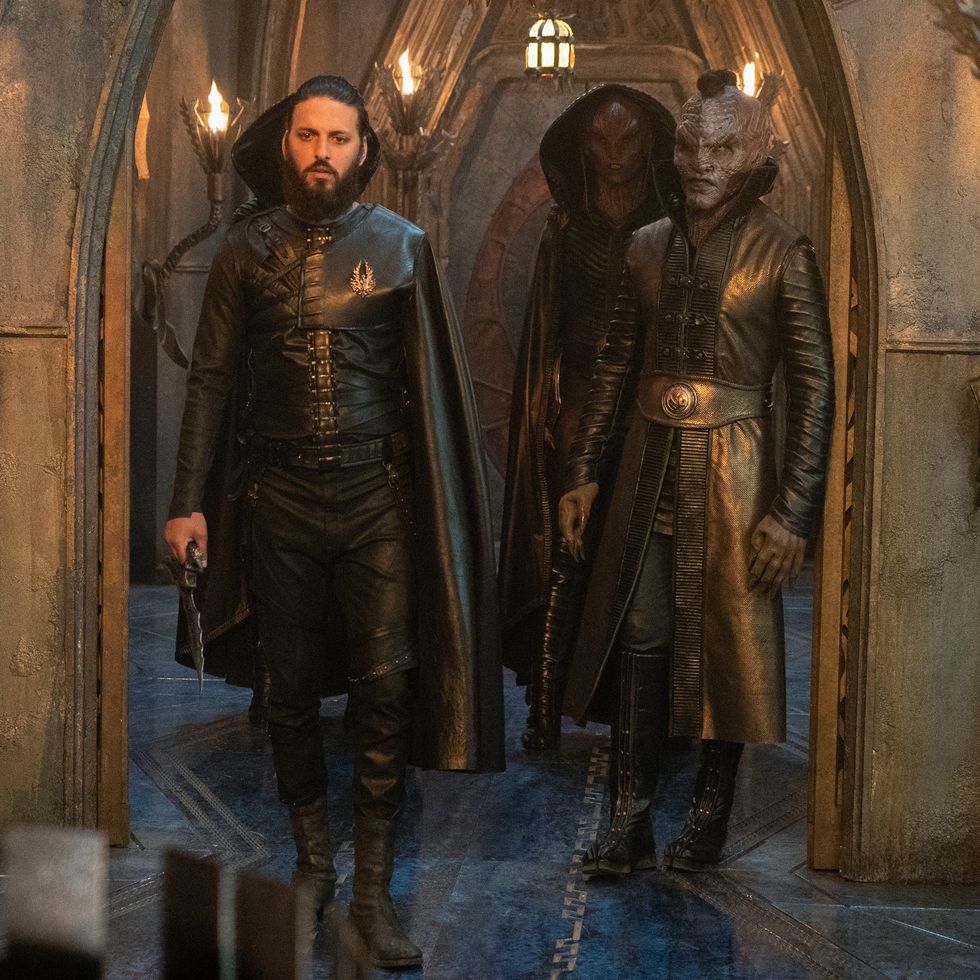
Phillips added that the costume design department works closely with the other departments on the show including the producers and production designers. The high level of communication between everybody ensures that viewers see an extremely rich and cohesive world.
"We communicate a lot," she said. "As soon as they break the story [of an episode], they'll give us an outline and it's about ten pages, sometimes less. It gives us an outline of what's going to happen in the episode.
"With that document, we have a department head meeting where we have the showrunners, myself, the production designer, prop, all the key players, our lighting guys, EP (executive producer)... we're all there.

"We're sitting in the room, and we read through the document and we flag any issues with whether we think we can get everything done within the timeframe and the budgets that we have to work with. And then we go from there.
"It's really collaborative, and everybody's there to make the best project we can with the products we have. It's a great experience."
Elsewhere, Phillips talked about the Discovery uniforms and why she made the uniforms gender neutral .
Star Trek: Discovery airs on CBS All Access in the US and Netflix internationally, including the UK.
Want up-to-the-minute entertainment news and features? Just hit 'Like' on our Digital Spy Facebook page and 'Follow' on our @digitalspy Instagram and Twitter account .
Chief Sub-Editor
Jess has more than 10 years of experience writing and editing online, specialising in entertainment.
As Digital Spy 's Chief Sub-Editor, they oversee the subs' desk while working with the wider team to ensure news and features content fits the brand's editorial vision.
Jess also helps with gaming coverage, including anything to do with The Sims , and has volunteered as a judge for the Independent Games Festival Awards since 2018.

.css-15yqwdi:before{top:0;width:100%;height:0.25rem;content:'';position:absolute;background-image:linear-gradient(to right,#51B3E0,#51B3E0 2.5rem,#E5ADAE 2.5rem,#E5ADAE 5rem,#E5E54F 5rem,#E5E54F 7.5rem,black 7.5rem,black);} Star Trek: Discovery

Star Trek: Discovery trailer promises sad goodbye
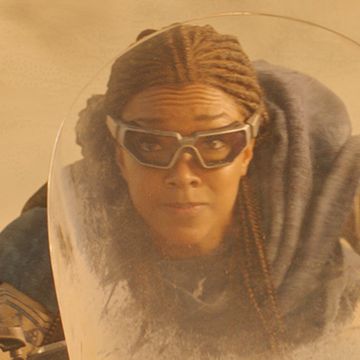
Star Trek Discovery sets final season release date
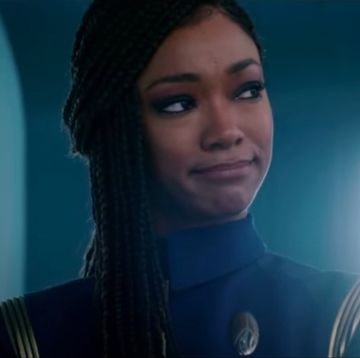
Star Trek: Discovery star opens up on show's end
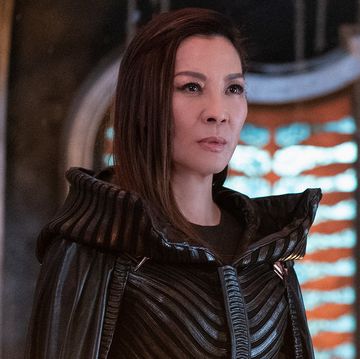
New Star Trek movie adds Ted Lasso and Power stars
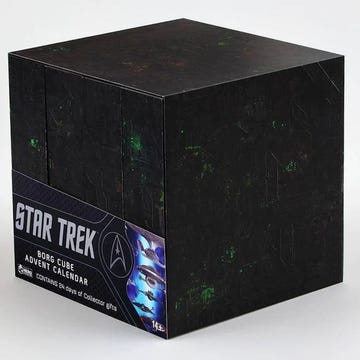
Star Trek advent calendar available to pre-order
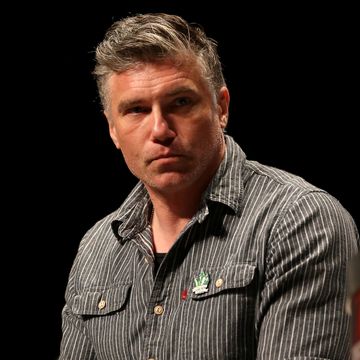
Star Trek: Discovery star addresses MCU return
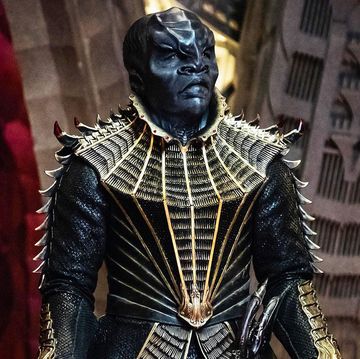
Star Trek confirms new Starfleet spinoff show
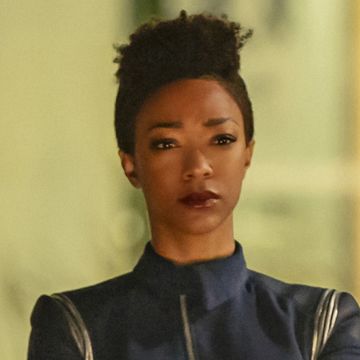
Star Trek Discovery season 5: all you need to know
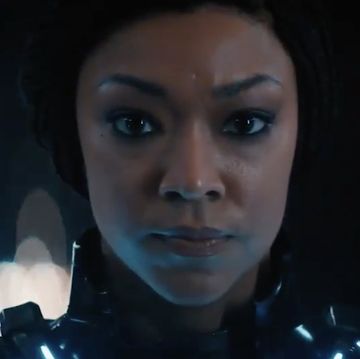
Star Trek: Discovery confirms when it will end
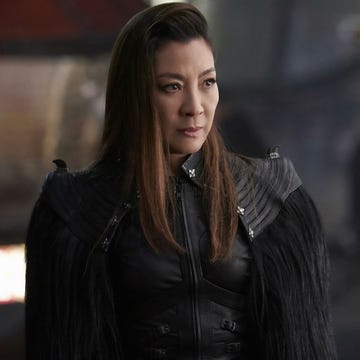
Star Trek boss gives update on Discovery spin-off

Star Trek: Discovery star joins NCIS: Hawai’i
A farewell ode to the Star Trek: Discovery Klingons
By michael atkins-prescott | may 3, 2023.

The redesign of the Klingons for Star Trek: Discovery was a flop. Now that they’re gone, we can acknowledge that it wasn’t all bad.
When it was announced that Star Trek: Picard season 3 would reunite the entire Next Generation crew for one last adventure, one awkward question lingered, what would Worf look like? Worf’s appearance in Picard would mark the first time a Klingon had been seen in live-action Star Trek since Star Trek: Discovery season 2. Their absence was due to Discovery flubbing their redesign of the Klingons so badly that no one really knew how they should be represented. Well, thankfully Worf looked exactly like you’d expect him to. And now that the Strange New Worlds season 2 trailer has been released, we’ve seen it features Klingons looking like they have since the beginning of the TNG era. So, I guess that’s the end of the Discovery redesign Klingons.
We hardly knew ye.
I did try to like the redesigned Klingons , I really did. But they just didn’t work. The problem was simple, it was too drastic. It was indicative of Discovery’s insistence that it wasn’t your grandad’s Star Trek, this was cool new Star Trek. Thankfully, the course correction was swift, and the new Trek series are no longer plagued with this novelty-above-all attitude.
Let’s talk about what was good about the Star Trek: Discovery design…
The head-to-toe latex prosthetics weren’t a bad idea. It accentuated the Klingon look, turning it up to 11. If only it hadn’t been accompanied by stuff that directly contradicted the classic Klingon look, like the bald elongated heads, weird skin tones, pointy fingers, and baroque ships. That’s the line that they shouldn’t have crossed, redesigns are a fact of a franchise that’s nearing the sixty-year mark, and sometimes they’re essential. But they should never contradict what’s gone before. Accentuate, exaggerate, reinterpret, but never contradict.
The other thing I liked about the Klingon redesign was that there was no convoluted explanation for it, they were simply a separate subspecies. Contrast this with the four-episode arc that Enterprise came up with to explain why the original series Klingons looked different from the TNG-era Klingons. Don’t get me wrong, it was a cracking story, but it was a very long answer to a question that no one asked.
(Besides, Deep Space 9 addressed the inconsistency with a single jokey exchange, and it’s one of my favorite Star Trek moments ).
Of course, there was a 100 percent improvement in Discovery season 2, when the Klingons grew their locks back. The hair really made a difference, giving us something that was new, but still recognizable.
The great thing about the subspecies explanation for the redesign is that it means that even if we never see the Discovery Klingons again, they haven’t been retconned out of existence. They share the world, with the traditional Klingons; they’re just kicking back, looking scary as all get out, while the traditional Klingons do shots with Spock.
Ranking every Star Trek film in franchise history according to metrics. dark. Next
Star Trek's Different Klingon Designs, Explained

Your changes have been saved
Email Is sent
Please verify your email address.
You’ve reached your account maximum for followed topics.

Star Trek Is Getting a Kelvinverse Origin, but Why Are Fans Skeptical?
Discovery: why doctor kovich's real name has major star trek implications, the rings of power's tom bombadil, explained.
- Star Trek: The Original Series introduced Klingons and created the franchise's most iconic aliens.
- The Klingons were redesigned for The Motion Picture and The Next Generation -era series.
- The rebooted Star Trek films and Discovery redesigned them further, but Strange New Worlds walked those changes back.
The Star Trek saga spans six decades and over 800 hours of storytelling on television and in film. While the universe created by Gene Roddenberry is vast and dynamic, the Klingons have appeared in every iteration of the franchise. Yet, since their debut in Star Trek: The Original Series in 1966, the Klingons' character design has changed over time. From regular humans with brown makeup and stylized facial hair to the intricate alien prosthetics on the characters in Star Trek: Discovery , there's more than one way to skin a Klingon.
Save for the odd standout like Khan Noonien Singh , heroes and starships are more important in Star Trek than its many villains . Instead, the alien antagonists that menace Starfleet explorers are mostly known by their species, like Romulans or the Borg. This is true of Klingons, which are immediately recognizable, though casual fans may not know General Chang from T'Kuvma. It wasn't until the debut of Star Trek: The Next Generation and Klingon bridge officer Worf that the franchise truly started to examine the culture of this war-like race. Thanks to his appearances in both Deep Space Nine and Star Trek: Picard Season 3 , Worf has appeared in more Star Trek episodes than any other character. He also laid the foundation for storytellers to create an in-narrative reason for the disparity in Klingon appearance. In the real world, the simple answer for the many different Klingon character designs comes down to money and technology.
RELATED: How Strange New Worlds Perfected a Star Trek: The Next Generation Premise
The Klingons in Star Trek: The Original Series Were Simple on Purpose
The Klingons were, effectively, created by Gene L. Coon, often called " Star Trek 's other Gene." He conceived of the characters as an allegory for the Soviet Union, according to the special features on the DVDs for Star Trek: TOS . Intended to be just one-off antagonists for the Season 1 episode, "Errand of Mercy," writer David Gerrold brought them back for Season 2's classic "The Trouble with Tribbles" episode. Crafting that story made the producers realize the Klingons could be the ongoing antagonist for Captain Kirk and the USS Enterprise crew they'd been looking for.
Despite being an expensive series, Star Trek: TOS was always struggling with budget and time. Makeup supervisor Fred Phillips worked with actor John Colicos to design the characters' look. However, outside of raised eyebrows -- similar to both Vulcans and Romulans -- and stylized facial hair, the Klingons were mostly defined by their glittery uniforms with a gold sash. The makeup process for The Original Series -era Klingons often took less time than even affixing Spock's Vulcan ears each day. The character design for early Klingons was simple and effective for TV, but that soon changed.
RELATED: Deep Space Nine Made Star Trek a 'Real' Franchise
The Klingons Look From Star Trek: The Motion Picture Through The Next Generation Era
Nearly a decade after The Original Series went off-the-air, Star Trek: The Motion Picture debuted and introduced fans to a new kind of Klingons. With significantly more budget and time to work with -- the Klingons appeared in only a single scene -- Fred Phillips wanted to make the aliens truly alien. The production of the first Star Trek film was fraught, so if Gene Roddenberry had any objections to changing the Klingon character design, he had bigger battles to fight. The Klingons appeared in each successive film save for The Wrath of Khan , and while their appearance was altered slightly, they maintained the same look.
However, it wasn't until Worf was added to The Next Generation cast that Roddenberry and the writers really began to think of them as a people rather than allegorical Soviets. Now that a Klingon was a hero character, he felt it was an injustice to the characters to reduce them to just being a warrior race. "I take the fact of their fictional existence very seriously," he said in the Star Trek 25th anniversary issue of Cinefantastique . In an interview in the special features of Star Trek: TNG 's first season, actor Michael Dorn noted that Black actors were routinely cast as Klingons to simply save time in the makeup chair. Over the next 18 years, makeup supervisor Michael Westmore had to create dozens of distinct Klingon characters.
In Enterprise Season 4 , the writers addressed the incongruity of the Klingon appearance in Star Trek: TOS with the second-wave era. A storyline was introduced about a genetic modification experiment that went awry. In order to cure a deadly, multi-species virus, Klingons were given a treatment that "smoothed over" the cranial ridges and teeth added to the design to make them look more alien. Yet, even the Klingons not affected by this mutation still looked more human than not. When former Star Trek: Voyager producer Bryan Fuller wanted to redesign them for Star Trek: Discovery , making them more alien was the goal.
RELATED: Star Trek: Humanity Was a Vulcan Pet Project for Centuries
The Design for Klingons in Star Trek: Discovery Was Very Controversial
During episodes of the now-defunct After Trek webseries during Star Trek: Discovery 's first season , the Klingon redesign was an often-discussed topic. The cranial ridges and teeth Fred Phillips added during the first redesign were extended to seemingly cover their entire body. They were given longer, clawed fingers and evolutionary characteristics that were more avian or reptilian than humanoid. The hope was to make the Klingons even more alien and frightening, but the design change proved to be a bit too drastic. By Season 2, the makeup artists gave them hair again. They also introduced a number of different skin tones beyond just brown.
Yet, by Strange New Worlds Season 2, the Klingons looked more like they did during the second-wave era. Unlike Enterprise , there was no in-narrative reason or the different look. The Klingon Empire is an interstellar society with hundreds of billions of citizens. Fans can easily explain away the difference as Star Trek 's continued commitment to Roddenberry's motto of infinite diversity in infinite combinations. Klingons are also able to reproduce with other Star Trek species, which could equally explain the difference.
In both cases, the redesign of the Klingons was meant to highlight their alien nature and take advantage of state-of-the-art makeup and prosthetics. The Discovery design may have been too successful, and franchise producers seem to have reverted the iconic antagonists to their Star Trek: TNG -era design . Still, no matter what they look like, Klingons are integral to Star Trek . They are enemies who became allies, which is the lesson Roddenberry always wanted his show to teach humanity.

Discovery Klingons and Star Trek's Continuity

Considering that its creators tell us that Discovery takes place in the Prime Universe, it is not possible to simply overlook the radical visual alterations made for the series. Without an official blessing, it is not possible for fans to dismiss Discovery and slap a "total reboot" or even a "non-canon" label on it, even if it is effectively a reboot and disregards essential parts of the canon. So even though much about Discovery feels wrong (not to say *is* wrong), EAS has to take care of issues like the Klingon redesign in some fashion. However, that still doesn't mean that EAS will cobble together speculative theories to make Discovery fit with canon.
Justifications
Various arguments are brought forward in defense of the redesign:
- The producers as well as some fans argue that the Klingons were changed before , when the so far human-looking make-up of TOS made way for the TMP appearance with the forehead ridge appliances. And even the TMP Klingons did not remain totally visually consistent, so some don't think it is a big issue if everything is changed yet again.
- Some defenders of the new look pretend that it is close enough to that of the TMP Klingons, the only notable difference being the lack of hair, and only in the first season.
- Another rationale brought forward is that the DIS Klingons, and particularly the House of T'Kuvma on their sarcophagus ship, could be a so far isolated sub-species of the Empire that for some reason becomes powerful in just one decade, only to vanish again or to undergo a mutation. This is not hinted at in Discovery though, and the series never shows any Klingons with old make-up for that matter.
- It is often cited as an important point that there are 24 Klingon houses with different looks now. But this new diversity is not in line with the unified warrior race we know from all TOS sequels as well as prequels.
- One frequently stated argument is that the redesign was sort of required to use of the most recent make-up techniques and to let the Klingons appear truly alien. The question is whether the intent to make them more alien doesn't go beyond the limitations of a "merely visual" alteration.
- Make-up FX designer Glenn Hetrick defended his new Klingons, calling the redesign an "evolutionary imperative" , based on the assumption that the species is a "cross between reptilian and avian" . But he ignores that the Klingons were always mammalians, and shouldn't "evolve" to birds or reptiles, not in an artistic and much less in a biological sense.
- Finally, a drawing of a hairless Klingon with an exoskeleton by Robert Fletcher for TMP was unearthed as a rationale for the redesign, as if a pre-production sketch discarded 40 years ago suddenly overruled the canon Klingon appearance in more than 400 episodes.
Speculation and wishful thinking doesn't help to make sense of the DIS Klingons, so let us stick with the facts. The following analysis shows how much the Discovery Klingons were changed and whether or not it could be possible to make them fit with canon. And yes, canon definitely includes visuals , as opposed to what some people want to make us believe in the wake of Discovery's repercussions.
Comparison of "Classic" and Discovery Klingons
We may want to add to the list that Discovery Klingons are unwieldy, compared to any of their predecessors of classic Star Trek. They also speak slowly, and with distorted voices.
Season 2 adjustment
In a revision of the revision, the Discovery Klingons get back their hair for season 2. Additionally, a few new characters such as Kol-Sha in DIS: "Point of Light" and the unnamed man on L'Rell's bridge in "Such Sweet Sorrow II" are given a make-up that is closer to the universally accepted look. L'Rell even loses a third of her skull volume, but this particular change remains an inexplicable exception. Other "long-headed" Klingons can still be seen in season 2. The growth of hair is explained in DIS: "Point of Light" as a tradition after the end of a war, as previously suggested by Mary Chieffo at New York Comic Con. The previous idea that there are sensory organs that must not be covered with hair is definitely obsolete now.

The notion that all Klingons without exception are bald during a war is absurd, considering that classic Klingons were more or less always at war in the 22nd, in the 23rd and in the 24th century and all of them always had hair (the only exception being General Chang). All Klingons of the different houses of Discovery, in contrast, had no hair even before T'Kuvma made the surprising suggestion to go to war against the Federation. Klingon children had no hair in T'Kuvma's flashback, and Mirror Voq was hairless as well. Perhaps the political changes brought about by L'Rell are the actual reason why Klingons grow hair again and never give up this custom again. But this conflicts with the uninterrupted continuity of classic "hairy" Klingons, and quite paradoxically Discovery postulates that the Klingons have totally conformist traditions at a time when they are said to be totally divided.
In any case, those Discovery Klingons must have amazing razors!
The beginning of the 100-year isolation of the Klingons mentioned in DIS: "The Vulcan Hello" corresponds to the time of ENT: "Divergence" when the Klingons began to mutate from the TMP to the TOS look. This period (in which no human has seen any Klingons?!) may serve as a loophole to explain the new mutation in a future episode.
- We should rule this out from the outset because the frequency of changes is so obviously ridiculous, even if it may not be a hard rule that all Klingons underwent all stages of the many metamorphoses.
- Where is the amazement about the new Klingon look? Burnham is just unfamiliar with the Torchbearer, but no one seems to have a problem with T'Kuvma's appearance.
- Also, would T'Kuvma's people celebrate their current, mutated state as the "pure" Klingon appearance? Totally unthinkable.
- If they are mutated, wouldn't the Klingons at least want to keep their hair?
DIS Klingons were an isolated sub-species that vanished after DIS
In season 1, the focus is on T'Kuvma and his closest allies. They all share the rare traits, while the actual majority of Klingons, the ones that might look as in TMP or even in TOS, are what seems to be a minority in Discovery.
- This theory would necessitate the appearance of a sufficient number of "old" Klingons in the series besides T'Kuvma's alleged sub-species. Perhaps the guy from "Such Sweet Sorrow II" would qualify but hardly anyone else.
- The 24 other houses, at least all of them who appear in "The Vulcan Hello", share the look of T'Kuvma's. There are some variations regarding the skull shape, but none that looks like an "old" Klingon. The main distinguishing mark is the styling (less heavily decorated costumes and weapons than T'Kuvma's house, for instance, and different hairstyles since season 2), rather than the biology.
- The gray-skinned DIS Klingon Kol is a member of the House of Kor (and an enemy of T'Kuvma). We can take for granted that this is the same house that Kor of TOS: "Errand of Mercy" belongs to. Kor underwent a metamorphosis (back) to his original Klingon look between TOS and his appearances on DS9. Could his relative Kol (and his father Kol-Sha) belong to a still completely different looking sub-species? Very implausible.
- Where were the DIS Klingons before DIS and where will they go after DIS? It may have to do with the sub-species being isolationist, but in season 2 it becomes apparent that even on Qo'noS they are the only type of Klingons to exist. The DIS Klingons would not simply disappear without a trace, and with never being referred to again.
(All) Klingons always looked like in DIS
The official policy, as by the repeated affirmations of the producers, is that Discovery is set in the Prime Universe and adheres to canon. If this is true, they have exempted visuals from canon, so Discovery is a reboot, but "only" on the visual side. In other words, we have to imagine that all Klingons always looked like in DIS. The return of their hair in season 2 is supposed to make the acceptance of the official policy easier but raises even more questions.
- The Klingon look of TOS was already iconic when TMP was produced. Many fans, as well as many people working behind the scenes, would have been upset if TMP had invalidated the look of TOS, even though it was the obvious choice for many years. Then DS9: "Trials and Tribble-ations" came along and set a standard: Visuals must not be ignored . If Klingons looked different in the past, so be it. If that doesn't fit with canon, we can and maybe have to try to corroborate its canon status, in this particular case with the ENT double feature "Affliction" and "Divergence". Not everyone may like this retcon, but it is how Star Trek used to work.
- Do we want Worf to look like in DIS ? Or any other prominent Klingon? Even with hair that would be unthinkable. Michael Dorn more or less ruled out that he would ever want to wear such a thick make-up that doesn't allow true acting, and even Alex Kurtzman conceded that Worf would have to remain Worf, should he appear on PIC.
- Hybrids like K'Ehleyr and B'Elanna may not even exist, seeing how non-humanoid the DIS Klingons are.
- In TNG: "Birthright II", Worf discovers that Ba'el has pointed ears, unlike the other Klingons, because she is a Klingon-Romulan hybrid. This plot point would be invalidated if all Klingons have pointed ears anyway, and much more alien than either humans or Romulans.
- As already mentioned, it makes no sense for Klingons to shave all their hair (and beards) during a war because they are a warrior race that is more or less always at war.
- The canon story of the ENT episodes "Affliction" and "Divergence" would be rendered absurd, as we would have to see in our minds something very different than what appears on screen. Since it is unbelievable that the DIS Klingons could profit from human genes and might mutate to human-looking Klingons, perhaps it would be better to abandon this whole ENT story, and ultimately the whole idea of human-looking TOS Klingons. Discovery would effectively become an incompatible reboot, not only visually.
- Mudd's description of the new Klingons as "pointy headed bastards" further corroborates their different look and jeopardizes the idea of a visual update we may be able to ignore.
DIS is a total reboot with no ties to the old Star Trek
Well, that is a conclusion we may draw for ourselves. But it is not supported by the official canon policy, which dictates that Discovery is "only" a visual reimagination.
Summarizing, Discovery fails to do two substantial things to justify the total redesign of the Klingons: give us a sufficient number of "classic" Klingons, and serve us some explanation why key figures of the Empire of the 23rd century (as well as their ships and styling) don't look familiar at all. The series has chosen to show only Klingons that look like T'Kuvma, L'Rell and Voq, by which Discovery implicitly declares itself a (total or visual) reboot, irrespective of all affirmations to the contrary.
The Klingons get back their hair and some other familiar features in season 2, but this is only damage control, in an attempt to make the unloved reboot series a bit more relatable.
Visual continuity has always been a quality mark of Star Trek, and an important part of its canon . With the extreme redesign of the Klingons and of everything related to them (such as the starships ), Discovery has abandoned this longstanding principle. The purported reason is that the producers of the series wanted to appeal to a "modern audience". But does this mean a total reboot was inevitable?
It is clear that Discovery couldn't have been made with the crude visual effects of the 1960s, with sets consisting of colorfully illuminated walls and with mustached TOS Klingons. There are wonderful fan-made TOS revivals such as Star Trek New Voyages and Star Trek Continues, but hardly any fan would honestly demand from a modern TV series to look like that (although this is a customary strawman used in an attempt to discredit my actual position). In fact, we already have an awesome and well-established Klingon make-up and styling since "Star Trek: The Motion Picture". There was nothing wrong or dated about the iconic look of the TMP Klingons and about their almost equally famous ship designs, like the D7/K't'inga or the Bird-of-Prey. They used to be the arguably most recognizable aliens of any science fiction series. Even casual fans and people with otherwise no ties to Star Trek were fond of the Klingon looks.
Still, the makers of Discovery decided to throw this legacy away. They replaced our beloved Klingons with a clumsy race that is barely capable of clear articulation and whose styling is ridiculously overblown. They turned one of the most formidable sci-fi civilizations ever created into a pseudo-religious xenophobic sect with foolish leaders. I could feel a little bit better about the unwarranted redesign of the Klingons if it were successful. The USS Enterprise NCC-1701 suffered a similar fate in Discovery, but the visual reboot of the ship in "Will You Take My Hand?" is at least aesthetically pleasing and still looks like an Enterprise. In contrast, everything about the all-new Klingons is just appalling.
It is true that Star Trek had plenty of inconsistent visuals already before Discovery, and few people have cared more for them than me. But with the new Klingons and some other questionable design decisions the makers of the series cross a line. We're not talking about the Trills , a race that appeared just once on TNG before it was decided to alter their appearance for DS9. We're not talking about make-up updates thanks to new techniques, like the moving antennae of the Andorians on Enterprise. We're not talking about something that may ever make sense in canon or only in our headcanon, like the previous changes to the Klingons. Discovery is and will always be visually incompatible with everything that came before. The visuals are one of several aspects in which Discovery is Star Trek in name only.
Discovery does not try to extend the painting the way that all previous series did, including Enterprise. It paints all over the canvas of the existing Star Trek. Setting the series in the 2250s was the first big mistake because canon problems are inevitable once new stories are shoehorned into an era that is already taken by an old series. It is odd how the producers themselves lament this setting as if they didn't anticipate the problems (Discovery being the third prequel in a row).
The second mistake, the visual redefinition, may have been more tolerable in a series set in an unclaimed era, and preferably in the future. It may have even been possible without any harm to the old Star Trek. Imagine Discovery were set in the 25th century and the new aliens are no Klingons but a race not yet encountered. The story could be still the same; only the token nostalgia, such as the character of Sarek, would have to be removed to that end.
With its actual setting, however, the series only adds insult to injury in a "historical" in-universe context. It is like the redesigned Klingons, ship designs, clothes and interiors speak to us, saying that the look of the old Star Trek was crap and that only the latest visual update is endorsed. I don't want to imply that the Discovery producers and production designers hate the style of the pre-existing Star Trek and wanted to get away with it at any rate. They may have done their best to make the design of the series work for themselves. But whatever their self-perception is, they totally failed to pay the old Star Trek the due respect. From now, watching the old Star Trek with the old Klingons is impaired by the knowledge that the manufacturer has ended the support for this legacy product.
It is good that the Klingons got back their hair and familiar looking ships in season 2. While this is only a small step on a very painful way to reconcile DIS with classic Star Trek, it shows that the people in charge listen to justified complaints and are willing to revise at least the worst errors of the series. Yet, I would have preferred a series that wouldn't make such glaringly obvious errors in the first place.
Update Notice
The Klingons vanished after the second season of Discovery, probably because the people in charge had recognized the complete redesign was unpopular. All members of the species that appeared in Lower Decks, Prodigy and Picard were TMP-Klingons. In the second season of Strange New Worlds, finally, the classic canon look of the species even returns to the "re-imagined" universe. As far as we can tell, Discovery Klingons are gone for good.

If Discovery Klingons never show up again (except perhaps in flashbacks using stock footage), we may be allowed to ignore these outliers in a greater in-universe context where Klingons are otherwise half-way consistent. In other words, we only have to acknowledge the existence of Discovery Klingons while we are watching Discovery.
The Klingon Forehead Problem - the history of the legendary continuity problem until Enterprise
The Evolution of Klingon Foreheads - fairly complete gallery and commentary
Dealing with Discovery Klingons - four options how future episode may handle the Klingon dilemma
The Visual Continuity of Star Trek - examples of if and how visual continuity was maintained through the generations
Discoverse Continuity Problems - where DIS and SNW are not in line with classic Star Trek
Thanks to Chris for the hint about the STID Klingons with hair and to Charles Eavenson II for the mentions of Klingon hair and claws, as well as the observation about the "reptilian ears".

https://www.ex-astris-scientia.org/inconsistencies/dis-klingons.htm
Last modified: 04 Nov 2023

© Ex Astris Scientia 1998-2024, Legal Terms
This website is not endorsed, sponsored or affiliated with CBS Studios Inc. or the Star Trek franchise.
Fleet Yards
Screen Rant
Star trek confirms the most feared species in the galaxy & it'll blow your mind.

Your changes have been saved
Email Is sent
Please verify your email address.
You’ve reached your account maximum for followed topics.
Star Trek Confirms the Final Frontier Is Secretly a Trap
Star trek officially unveils its realm of the gods the pleroma, 10 times star trek was referenced on supernatural.
- Star Trek #19 delves into the fear and mystery surrounding god-like beings in the universe, exploring the impact they have on mortals.
- The story emphasizes the importance of gods remaining hidden to avoid inciting fear and aggression from lower life forms.
- The Organians take on a disguise to conceal their true power, showcasing the rationality behind gods avoiding direct contact with mortals.
Warning: contains spoilers for Star Trek #19!
The Star Trek universe is full of species that strike fear into the hearts of Federation citizens, but the most feared of all will blow fans’ minds. Species like the Borg or the Jem’Hadar are scary and feared throughout the galaxy. Yet in Star Trek #19, as T’Lir, the last of the Organians, reflects on their life, they reveal another species is an even bigger potential threat.
Star Trek #19 is written by Jackson Lanzing and Collin Kelly and drawn by Megan Levens. Prior to incorporating as a Vulcan, T’Lir lived on Organia. They recall a conversation with their father, who shed light on the status of the universe’s god-like beings. Their father tells them that if they want a bright future, they must remain hidden. He goes on to explain that the galaxy is full of life, many of which have gods.
They conclude their exile is necessary, as these lower life forms fear the gods.
Star Trek's Day of Blood Explored What The Gods Mean to the Galaxy
Not all of the gods were friendly.
In 2022, IDW gave their line of Star Trek comics a shot in the arm with the landmark Star Trek #400, which seeded the god war storyline. This story, which culminated in the Day of Blood crossover event, saw Kahless, the Klingon Emperor, launch a genocidal campaign against the gods. In quick succession, Kahless killed all but one of the Organians, Gary Mitchell and the Crystalline Entities. The book has used this war as a way to explore what it means to be a god–and what it means to be an adherent.
God-like beings have been a part of the Star Trek fabric since its inception. The aforementioned Gary Mitchell first appeared in the show’s second pilot, establishing a precedent that would stretch across multiple shows and movies. In Star Trek’s 58-year history, fans have met the likes of the Metrons, the Q, Trelane, Charlie X and many others. Each one of these possessed fantastic powers beyond mortals, and not all of them were friendly either. For instance, Trelane toyed with the crew of the Enterprise, and was only defeated when more of his species showed up to take him back home.
The Gods Have Good Reasons for Avoiding Mortals
The gods of star trek inspire fear in the hearts of the galaxy.
Entities like Trelane ensured demagogues like Kahless would take up arms against them, seemingly confirming T’Lir’s father’s observation. Lesser beings fear that which they do not understand, and the gods, being so far beyond them, are the ultimate unknown–and thus targets of fear. The Organians understood this, and took steps to hide their existence. They initially appeared to Kirk and company as pre-industrial peasants, which undermined their great power. Other god-like beings in the Star Trek universe take similar approaches when dealing with mortals, and given the fear and mistrust, it may be a rational course of action.
Star Trek #19 is on sale now from IDW Publishing!

IMAGES
VIDEO
COMMENTS
The redesign of the Klingons for Star Trek: Discovery may be one of the most controversial topics in the Trek fandom. When fans first saw the new Klingons, many were very upset that the newest ...
Star Trek: Discovery kicked off a new era of Star Trek shows in 2017, and Discovery's 1st season heavily featured the Klingons. However, the species underwent another dramatic redesign like they had in the TOS movies. The new design made the Klingons look even more alien, taking away their hair and giving them a larger head and more pronounced forehead ridges that extended up the entirety of ...
Hardcore Star Trek fans know that for every single change to a classic alien species, there's usually some kind of in-universe explanation. But when it comes to the debut of new Klingons in the ...
The Klingons underwent a complete redesign for the first TOS movie, "Star Trek: The Motion Picture."According to "The Making of Star Trek: The Motion Picture," costume designer Robert ...
Worf's own Klingon design changed gradually over his time on Star Trek too. Then Discovery came along and upended it all again. It shook things up entirely and the Klingons looked brand new once again. Here, with Star Trek Strange New Worlds season 2, we're firmly back in TOS-movie/TNG territory, and it looks like the Discovery redesign has ...
One of the more startling elements of "Star Trek: Discovery" was the redesign of the Klingons. They were given larger, elongated heads and were stripped of their hair. The Klingons' eyes ...
Per Trek Movie, the show's creature designers Neville Page and Glenn Hetrick have revealed that these new Klingons are bald with more pronounced ridges - because they're basically sensors. The ridges are tools that the Klingons, a predator race, utilized to climb the food chain. Actor Mary Chieffo, who plays Klingon L'Rell, expanded on that idea.
Enter Star Trek: Discovery, the first new Trek TV for well over a decade, and we have a redesign that is quite a significant departure from the classic Klingon and has almost nothing in common ...
The controversial Klingon redesign overshadowed the many positives of Star Trek: Discovery season 1.Although they retained the cranial ridges and warrior's armor they were shorn of their TOS-style facial hair and TNG-style long hair.These differences could have been explained by Discovery's villain T'Kuvma (Chris Obi) who wished to return to a more traditionalist way of life.
The Klingons too have been updated repeatedly, to which Star Trek: Discovery bosses explain the latest change. Where Star Trek films famously redesigned Klingons with ridged foreheads that ...
At the beginning of Star Trek: The Motion Picture, we see a Klingon ship get absolutely obliterated by V'Ger, and even more excitingly, we also get to see the Klingon redesign. Here, the Klingons look like proper aliens to match their warrior spirit and harsh language. Even the TOS movies couldn't be consistent, though, and the likes of ...
★Subscribe Here: https://goo.gl/eMyqR8In today's Star Trek: Discovery video, CJ explores and explains one of the most controversial aspects of the new show: ...
So for season 2, the show has decided to dial things back. Starting with this week's episode, the Klingons will look more like they did in The Next Generation. Each Klingon redesign has a simple ...
During episodes of the now-defunct After Trek webseries during Star Trek: Discovery 's first season, the Klingon redesign was an often-discussed topic. The cranial ridges and teeth Fred Phillips added during the first redesign were extended to seemingly cover their entire body.
There is precedent for such a thing. On Star Trek: Enterprise in 2005, they finally explained after 40 years why the original Klingons looked the way they did. Long story short, it was due to a ...
Redesign. For Star Trek: The Motion Picture (1979), the Klingons' appearance was radically changed. To give the aliens a more sophisticated and threatening demeanor, the Klingons were depicted with ridged foreheads, snaggled and prominent teeth, and a defined language and alphabet. ... Star Trek: Klingon, requires players to learn the language ...
By Jess Lee Published: 24 February 2019. Star Trek: Discovery costume designer Gersha Phillips has shed more light into the redesign of the Klingons between seasons one and two. For the second ...
The redesign of the Klingons for Star Trek: Discovery was a flop. Now that they're gone, we can acknowledge that it wasn't all bad. When it was announced that Star Trek: Picard season 3 would reunite the entire Next Generation crew for one last adventure, one awkward question lingered, what would Worf look like? Worf's appearance in Picard would mark the first time a Klingon had been ...
The Klingon Empire is an interstellar society with hundreds of billions of citizens. Fans can easily explain away the difference as Star Trek 's continued commitment to Roddenberry's motto of infinite diversity in infinite combinations. Klingons are also able to reproduce with other Star Trek species, which could equally explain the difference.
Discovery Klingons and Star Trek's Continuity. Star Trek Discovery reimagines or redefines many staples of Star Trek. The total redesign of the Klingons is the arguably most dramatic among the many deliberate visual changes in the series. The species doesn't only lose the hair, but essential features of the Klingon body look totally different than the established appearances of TOS Klingons or ...
There's a big difference between the redesign from TOS to TMP when there basically hadn't been any other Trek for a decade, and the Disco redesign that was done after TNG, DS9, Voy, ENT and multiple other entries into the Trek franchise had not only firmly established what Klingons look like, but even provided an in-universe explanation for the ...
The depicted Klingon is a typical warrior, battle-hardened and scarred. Osteoderms covering the face and forehead act as natural armor. A massive mane of hair defines him as a mature male that is in excellent health. Klingon's prefer melee weapons in combat, especially the bat'leth.
A massive mane of hair defines him as a mature male that is in excellent health. Klingon's prefer melee weapons in combat, especially the bat'leth. This heavy and complex polearm is steeped in tradition and ritual. Artist notes: this version of my Klingon redesign is completely different from any of my previous attempts.
In 2022, IDW gave their line of Star Trek comics a shot in the arm with the landmark Star Trek #400, which seeded the god war storyline. This story, which culminated in the Day of Blood crossover event, saw Kahless, the Klingon Emperor, launch a genocidal campaign against the gods. In quick succession, Kahless killed all but one of the Organians, Gary Mitchell and the Crystalline Entities.